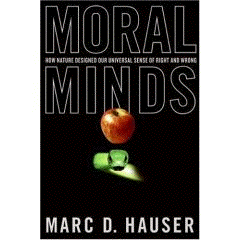 - Tempted by the truth of another
-
- When is it permissible for one animal to
harm another? The discussion thus far suggests
that animals harm others during predation, while
attacking members of a neighboring group, while
beating up a lower-ranking group member, during
an infanticidal run, and while redirecting
aggression as a mechanism to reduce postconflict
tension. Paralleling our discussion of human
violence, there is no single deontological
principle guiding animal violence that dictates,
plain and simple, that harming another is
forbidden. Nor is there a principle that states
that harm is permissible whenever it feels
right. We explain variation in the expression of
harm by appealing to principles and parameters
that are grounded in action, and especially the
causes and consequences of different actions.
But in addition to the Rawlsian contribution,
there is also a Humean component. Let's return
to an earlier example to see how this might
work.
-
- When an aggressor reconciles with its
victim, there is some sense in which this
interaction looks like a sympathetic or perhaps
empathetic response. In chapter 4, I discussed
some of the work on human empathy,
inspired by Hoffman's pioneering research, and
mapped out more recently in terms of development
and neural correlates by Nancy Eisenberg, Andrew
Meltzoff, and Tania Singer. For some, empathy
entails more than feeling the same way as
someone else. It entails knowing or being aware
o1 what it is like to be someone else. In its
simplest formulation, empathy grows out of a
mirror neuron-like system, where my perception
of an event is mirrored by my enactment of the
very same event. Once in place, however, this
form of empathy is transformed-either in
evolution or in development-by the acquisition
of mind-reading skills. With this new capacity,
individuals can think about what someone else
feels, imagine how they would feel in the same
situation, work out what would make them feel
better, and from this deduce how to make the
other person feel better.
-
- Do animals have anything like the first or
second form of empathy? In my discussion of
empathy in humans, I mentioned the interesting
observation that people who are more empathetic
are more susceptible to yawning.
Yawning is generally contagious. But it
is really contagious if you have a big heart,
unable to turn off your compassion for others.
Based on this correlation between yawning
and empathy, the psychologist James Anderson
wondered whether other animals might also be
susceptible to contagious yawning. 39
Captive chimpanzees watched videos of other
chimpanzees yawning and doing other things.
Though inconsistent across individuals, some
individuals consistently yawned back. We can't
say that the yawners are empathetic while the
non-yawners are not. What we can say is that
given the observation that contagious
yawning is a signature of empathy in humans,
it is possible that the same holds true for
chimpanzees
and other species. This possibility, as well as
other observations of caring in animals, sets up
a more specific look for empathy.
-
- In nature, rats forage in the company of
other rats and often learn from them. In the
laboratory, naïve animals learn what to eat
either by following knowledgeable individuals or
by smelling their breath. Although rats are
social eaters, they do not naturally forfeit the
opportunity
-
How do humans develop their capacity to make
moral decisions? Harvard biologist Hauser (Wild
Minds) struggles to answer this and other
questions in a study that is by turns
fascinating and dull. Drawing on the linguistic
theories of Noam Chomsky, Hauser argues that
humans have a universal moral grammar, an
instinctive, unconscious tool kit for
constructing moral systems. For example,
although we might not be able to articulate
immediately the moral principle underlying the
ban on incest, our moral faculty instinctually
declares that incest is disgusting and thus
impermissible. Hauser's universal moral grammar
builds on the 18th-century theories of moral
sentiments devised by Adam Smith and others.
Hauser also asserts that nurture is as important
as nature: "our moral faculty is equipped with a
universal set of rules, with each culture
setting up particular exceptions to these
rules." All societies accept the moral necessity
of caring for infants, but Eskimos make the
exception of permitting infanticide when
resources are scarce. Readers unfamiliar with
philosophy will be lost in Hauser's labyrinthine
explanations of Kant, Hume and Rawls, and Hauser
makes overly large claims for his theory's
ability to guide us in making more moral, and
more enforceable, laws.
-
 -
- Marc
Hauser's eminently readable
and comprehensive book Moral Minds is
revolutionary. He argues that humans have
evolved a universal moral instinct,
unconsciously propelling us to deliver judgments
of right and wrong independent of gender,
education, and religion. Experience tunes up our
moral actions, guiding what we do as opposed to
how we deliver our moral verdicts.
-
- For hundreds of years, scholars have argued
that moral judgments arise from rational and
voluntary deliberations about what ought to be.
The common belief today is that we reach moral
decisions by consciously reasoning from
principled explanations of what society
determines is right or wrong. This perspective
has generated the further belief that our moral
psychology is founded entirely on experience and
education, developing slowly and subject to
considerable variation across cultures. In his
groundbreaking book, Hauser shows that this
dominant view is illusory.
- Combining his own cutting-edge research with
findings in cognitive psychology, linguistics,
neuroscience, evolutionary biology, economics,
and anthropology, he examines the implications
of his theory for issues of bioethics, religion,
law, and our everyday lives.
|


